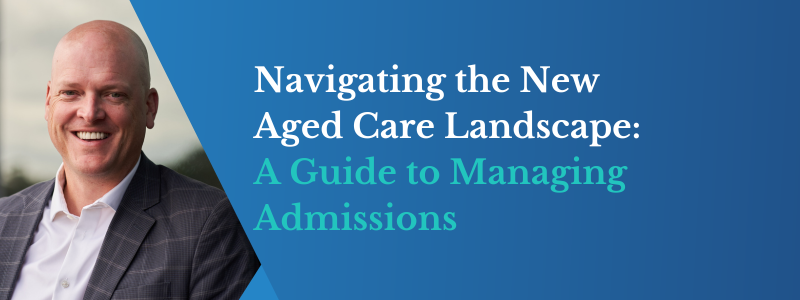A Guide to Managing Admissions
September 8, 2023 | Aged Care Management

By Tyler Fisher, Data Scientist
Navigating the New Aged Care Landscape
The aged care industry is undergoing significant changes in response to government policies and evolving market dynamics. As part of these changes, the management of Refundable Accommodation Deposits (RADs) and Daily Accommodation Payments (DAPs) has become a critical aspect of financial governance for aged care providers. In this blog, we will explore the key steps and strategies involved in effectively managing accommodation revenue.
Define your goals
Before diving into the intricacies of RADs and DAPs, it’s essential to define your short to medium-term financial goals. These goals can include building a financial “war chest” or ensuring healthy cash flow while managing the cost of capital. The first step is to prioritize these goals based on your facility’s unique circumstances.
Optimal Pricing and Mix
To achieve your financial goals, it’s important to determine the optimal pricing and mix of RADs and DAPs. Robust financial modelling is required to find the right balance, considering available room types and facility-specific factors. This modelling should be used to prepare a RAD/DAP pricing schedule and occupancy targets, which will support decision-making and allow transparency. Additionally, regularly monitor local and national price changes to remain competitive.
Educating Stakeholders
Governing bodies need to understand why the existing business model is now at the end of its useful life cycle. Educating your board and stakeholders about the need to improve accommodation revenue through a new pricing structure can be done through modelled cash flow projections and bond/RAD balances. Analysing the P & Ls of different cost centres can help stakeholders understand the changes.
Ongoing Management
Managing admissions is an ongoing process that requires meticulous attention. Here are some critical actions to consider:
- Managing Capital: Use a system specifically designed to manage bonds and RADs, ensuring compliance with reporting requirements.
- Communication: Regularly communicate pricing changes to staff and provide guidelines to support conversations with prospective residents and their families.
- Monitoring and Optimisation: Use tools and develop processes to continuously monitor accommodation cash flow and debt/bond positions. Run different scenarios to optimize your financial position.
- Training: Provide education for staff to ensure they understand the importance of accommodation revenue. This may include certification or Continuing Professional Development (CPD) programs.
- Resource Allocation: Consider hiring appropriately skilled staff to handle the complexity of admissions management.
Sales and Marketing Strategies
Effective pricing and marketing strategies are vital to attracting residents and their families:
- Pricing Transparency: Determine pricing that aligns with the product offering, local area house prices, and government guidelines. Publish this information on your website.
- Information Submission: Submit facility and room details to MyAgedCare as required, ensuring accuracy and compliance with formatting guidelines.
- Sales Materials: Design sales materials that differentiate your facility in a competitive market.
In conclusion, managing admissions and the associated accommodation revenue is a complex and ongoing process that requires careful planning, financial modelling, education, and transparency. By following these steps and strategies, providers can navigate the changing landscape of aged care finance while providing residents and their families with clarity and confidence in their pricing options. Mirus can help with our personalised Accommodation Pricing Report to help you understand your competitors, room types and pricing so that you can compete with the right price and right goals for your organisation.


